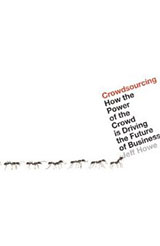 My notes on “Crowdsourcing: How the Power of the Crowd is Driving the Future of Business” by Jeff Howe
My notes on “Crowdsourcing: How the Power of the Crowd is Driving the Future of Business” by Jeff Howe
8 Very Successful Crowdsourcing Examples
1. Threadless
- Threadless receives thousands of designs each week
- The Threadless community of millions votes
- The company selects nine from the top hundred to print
- Each design sells out
- Hardly surprising given the fact Threadless has a fine-tuned sense of consumer demand before they ever send the design to the printer
- Threadless isn’t really in the T-shirt business. It sells community
2. iStockPhoto
- Photographers get royalties for signing over their rights to their photos
- Some photographers were making six figures a year selling photos they’d already been paid to shoot, yet stock photography remains, in comparative terms, a tiny industry. The annual global gross for the industry is US$2 Billion, which makes it a bit bigger than the market for gift baskets, but a little smaller than the annual sales of orchids.
3. InnoCentive
- Innocentives clients include Fortune 500 firms like P&G, DuPont, and BASF. When the company’s in-house R&D teams can’t solve a problem, they hand it over to the 140,000 scientists from more than 170 countries that regularly scan InnoCentive’s website looking for work.
- Most rewards for successful solutions pay between $10k to $100k, but money is not a primary motive
- In one MIT study into InnoCentive revealed that solvers were more successful when they had less experience in the relevant discipline. The untrained are also untainted. Their greatest assets is a fresh set of eyes
- “Diversity Trumps Ability Theorem” suggests “a randomly selected collection of problem solvers outperforms a collection of the best individual problem solvers”. People of high ability are a homogeneous group. Many of them have been trained in the same institutions, and they tend to possess similar perspectives and apply similar problem-solving techniques. They are indeed better than the crowd at large but at fewer things.
4. Wikipedia
- Encyclopaedia Britannica had just posted all 100,000 entries onto it’s website, all free, but Wikipedia went ahead anyway, and has millions of articles now
5. IBM’s Peer-to-Patent Project
- In recent years a consensus had emerged within the intellectual property field: the patent system was broken
- IBM announced their “Peer-to-Patent Project”
6. Amazon
- Amazons collaborative filters analyse connections between items rather than suers. The books don’t have anything in common and yet the people who buy one often buy the other. How? Why? It doesn’t matter. Amazon just knows it drives sales
7. Digg
- Social news sites are playing an increasingly prominent role in the complex information ecology of the Web. Like Del.icio.us and Flickr, Digg does one single thing very well – it allows users to vote for links that other users submit
- When a DVD company demanded Digg took down a link to a code under copyright, Digg complied but the links kept being voted up, until Digg relented “after seeing hundreds of stories and reading thousands of comments, you’ve made it clear. You’d rather see Digg go down fighting than bow down to a bigger company. We hear you, and effective immediately we won’t delete stories or comments containing the code and will deal with whatever the consequences might be. If we lose, then what the hell, at least we died trying.”
- Digg doesn’t have a firewall like an editor at a newspaper. The crowd made the decision to publish the code.
8. Google
- Not only does Google’s search engine essentially use a form of crowdsourcing to organise its results, but the company has come to rely on the crowd’s input for everything from Google Earth to the categorisation of images.
A warning for companies using crowdsourcing
- Companies employing crowdsourcing don’t get a free ride
- Those that view the crowd as a cheap labour force are doomed to fail.
- What unites all successful crowdsourcing efforts is a deep commitment to the community.
- The crowd wants to feel a sense of ownership over its creations, and is keenly aware when it is being exploited.
- The earth is flatter than anyone ever imagined
- The crowd doesn’t want to talk to you, they want to talk to each other. Don’t try to control the discussion just provide the room in which it takes place
- The rule of participatory media: the 1:10:89 rule (or 1:9:90) rule: For every 100 people on a given site, 1 will actually create something, another 10 will vote on what he created, and the remaining 89 will merely consume the creation

Superb post. Thanks for sharing, Sheldon!